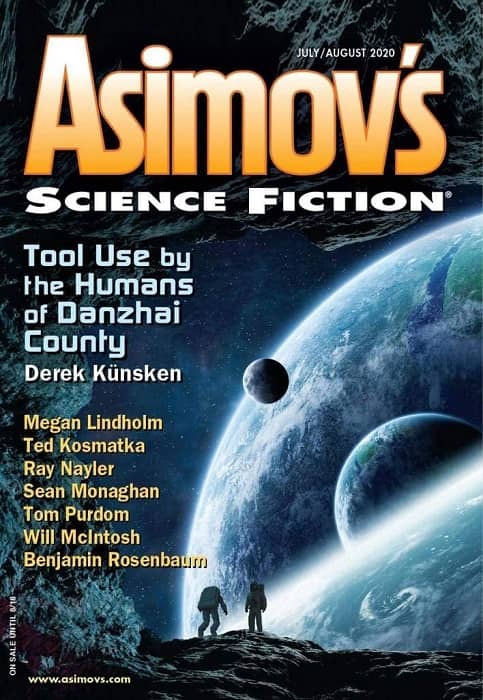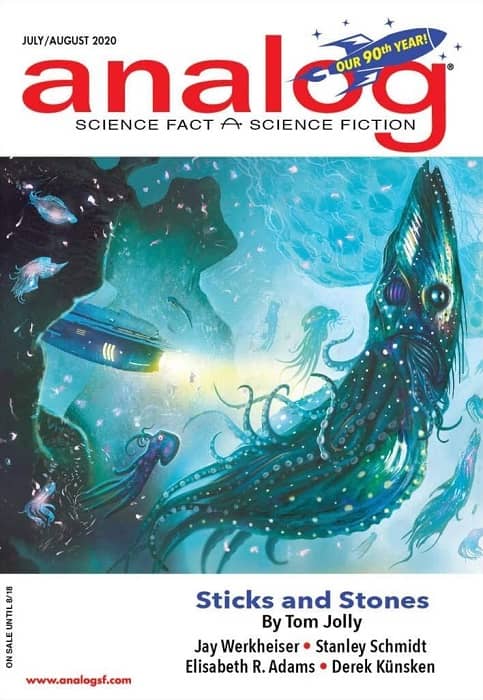If I Were a Movie Maker: Dell Science Fiction Reviews
 |
 |
Analog cover by Dominic Harman
This issue of Asimov’s starts out with a bang, with two standout stories.
In a perfect world, the first of them, “Nic and Viv’s Compulsory Relationship,” by Will McIntosh, will be optioned for a feature length romantic comedy starring the latest and hottest Hollywood crushes. The female lead will be played by someone who can convincingly be a pragmatic professional. The male lead will be well-liked and unpretentious.
We also should enjoy the two other important cast members — the people with whom our heroes are not supposed to be — despite their too-obvious flaws. They’re just not right for our true lovers, and it’s no one’s fault, really.
Here’s the plot: the city manager, an A.I. (a fourth, important casting choice), endeavoring to make her city even happier, forces our two leads to go on a series of dates. Even though these two individuals already are “in love” and engaged to others, the A.I. insists that this is a mistake: she has analyzed the data and she insists that our favorite potential couple actually is meant for each other. Romantic comedy gold, right?
With the bonus of a sci-fi element. Of course, setting these two up as a test run for the A.I.’s eventual all-city dating service is only part of the story. If you want to know more — and if the A.I. is right, if these two actually are “meant” for each other — you will have to read the tale. Or, better yet, in that perfect world, wait for the movie.
The second story, “Father,” by one of my favorite contemporary writers, Ray Nayler, is sure to appear in a Best Of at some point. It’s a bit of nostalgic, small-town Americana — a parallel America, that is, in which alien tech has been salvaged from a crashed saucer from 1938 and used for many purposes in 1956, including aid in winning a recent, American-led WWII. As such, it reads, to me, like Stephen King’s violence and an unflinching regard for the worst of human characters writing Ray Bradbury’s normal “folk” dealing with weird, everyday tech.
On June 1, 1956, a robot arrives to replace the father, one who died in the recent war, of our narrator. Things are not quite as they seem with this robot father, but I’ll leave that to you to discover. Better not wait for a movie on this one. Nayler’s prose, as always, is crazy good. I don’t know if film can capture these little details (textures found in Stephen King’s writing, too, and, considering, cinema does plenty with his work) which sadly may become mere memories of reality for all of us: “Mom bought Father a glove and a bat and we played ball out in the lumpy vacant lot. High pop flies lost in the evening sky. The chirping of crickets that fell silent when you came too close.”
And now — ready? — you’re going to hear about this one, and you can say that you heard it here first. “The Beast Adjoins,” by Ted Kosmatka. This is going to make science fiction history.
It’s about A.I. again, but whereas the A.I. in the first story mentioned here is a benign social planner, and whereas the A.I. in the last story that utterly and profoundly impressed me (“Sojourner,” by Craig DeLancey) may or may not be empty software designed solely to manipulate human emotions, this A.I. is humanity’s greatest fear. This A.I. is like that in the Terminator franchise. Or Matrix. But it might be far, far worse than either of those.
Read this story. Read it. I am astounded at how much visceral content Kosmatka covers in a mere seventeen digest pages. While reading, as I neared the finish, I knew it was going to be an important story. Knew it. I had determined that it was an instant, mind-blowing classic. And then it threw me one more bonus.
Many of you must know by now that, in my worldview, I am something of a theist, a spiritualist. By now I have read many, many science fiction stories in which human personalities — their brain patterns — are mapped onto computer data, and hence they live, even if their biological bodies happen to be destroyed.
But, as a spiritualist, this never satisfies me. It seems somehow not true that all we are as souls, as persons, are patterns on the fabric of SpaceTime. It is difficult for me to believe that, turn my brain’s electrical signals into analogous computer data in some mainframe, let my body die, I somehow live on in that computer. I mean, my pattern lives on, sure, and I’m happy for that last vestige of myself, but I can’t believe that that person is me any more than a hundred, million clones of me would all, also, be me. Instead, I believe that there is an ineffable something in and beyond my biological body that will be absolutely gone were this body to die.
As I neared the end of Kosmatka’s tale, and as these familiar thoughts of mine returned in response to Kosmatka’s concluding content, Kosmatka suddenly addressed my philosophical objection in a way I never had encountered before. Oh, it is gorgeous! I must warn you, since I’m not giving anything away here, you might be tempted to believe that Kosmatka offers answers. Don’t expect so much, but expect to have your mind blown and to enjoy one of the worthiest twists in science fiction literature.
After all that excitement, perhaps you think I have nothing left to say about Derek Kunsken’s “Tool Use by the Humans of Danzhai County.” I do. It’s an ingenious simulation of what I hope is our near future. Kunsken tells a story in two generations, a father and a daughter, about how their geniuses and passions indelibly change their world — our world. The science is real, so the outcome is possible, and the outcome is profoundly optimistic, if powerful tools for social change can be produced and disseminated by right-hearted, right-minded individuals. It’s possible.
It seems that most of my love is for Asimov’s this bi-month. My only notes concerning Analog this time around involve “The Offending Eye,” by Robert R. Chase, and The House of Styx, Part III, by, of course, Derek Kunsken.
Chase’s work is swiftly addressed. His tale is a novella, but it’s set in a universe and uses the same characters as other stories of his that I have read in these pages. I am becoming familiar with his subcreation of a future universe, and I’m really liking it. The powers at play here are traditional humans (the Stability), A.I., TransHumans, Eternals (humans that live forever, at the expense of a propensity for auto-immune diseases), and alien societies (I think) evocatively called the Cube Builders and Sparks.
Praise for Kunsken you can read here. My concluding comments at this time are that this serial feels in no way “ended” for me. I, for one, possess a secret theory concerning a very important character. And a clearly absent resolution involves the presence of the sublime or numinous that so powerfully hooked me in the first installment. I expect either that more is coming (that the “conclusion” here is arbitrary) or that I have read a repurposed truncation of a much longer work, perhaps one expected for future, novel-length publication.
Asimov’s Science Fiction and Analog are available wherever magazines are sold, and at various online outlets. Buy subscriptions at the links below.
Asimov’s Science Fiction (208 pages, $7.99 per issue, one year sub $47.94 in the US) — edited by Sheila Williams
Analog Science Fiction and Fact (208 pages, $7.99 per issue, one year sub $47.94 in the US) — edited by Trevor Quachri
The current issues of Asimov’s and Analog are on sale until August 18. See the last article in this series here, and all our recent magazine coverage here.
Gabe Dybing has been a small magazine editor (Mooreeffoc Magazine 2000-2001), often a writer, and usually a gamer. He is most interested in the “northern” fantasy tradition and frequently examines intersections between that topic and gaming. For Black Gate he has contributed many articles, including pieces on Poul Anderson, J.R.R. Tolkien, and roleplaying games.